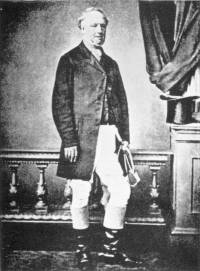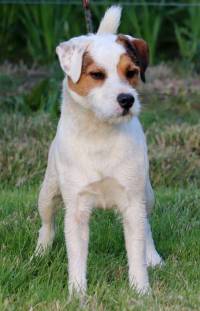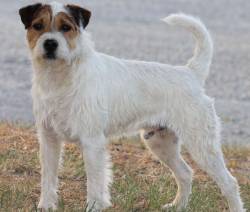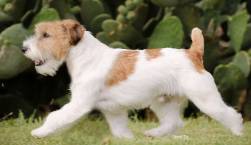Parson Russell Terrier
 Parson Russell Terrier
Parson Russell Terrier
The Jack Russell Terrier and Parson Russell Terrier are two different pure breeds.This is because they were developed in two different countries. Confusingly they were both developed from the terriers kept by the same man, the Reverend Parson Jack Russell. Known as the 'Sporting Parson', he kept his own private register. His terriers became legendary in their own right.
To complicate matters, by the mid-1800's, some of his terriers had been developed into showdogs. These were exhibited as third breed, the Fox Terrier. Their pedigrees were kept by the Kennel Club (UK). However, it is the terriers that remained working terriers that, more than a century later, were developed into two other different pure breeds, the Jack Russell Terrier of Australia and the Parson Russell Terrier of England.
The Legacy of Parson Jack Russell (1795-1883)
 Parson Jack Russell
Parson Jack Russell
Parson Jack Russell began his lifetime passion in 1815 with a Terrier bitch called 'Trump'. T.H.Scott wrote in the 'Sportsman's Repository' in 1820 that other Terriers at that time existed that were just as perfect point for point as "Trump". However, it was 'Trump who laid the foundation for the Parson's strain of working Terriers.
Parson Jack Russell was a founding member of the Board of the first Kennel Club (UK) and a terrier judge. Despite this, he kept his own private registry of his own dogs. This separate strain of terriers was selected singularly on their gameness. Consequently, it was only the Reverend Jack Russell 's Terriers that had the ability to work and do the job required that had their names recorded in the Parson's private Stud Register.
Simultaneously, the pedigrees of the showdogs were recorded in the Kennel Club (UK) Stud Books, and were called pure-breeds. These, confined to dogs which competed in shows, were re-named Fox Terriers.
"[Parson] J. Russell, who is certainly the father of fox terrier breeders, tells us that he has bred his dogs since 1815, and their pedigree has been kept quite pure,... "[1].
Consequently, Parson Jack Russell witnessed the gene pool some of his original working Terriers split off into showdogs called Fox Terriers. But it is indisputable that his respected old fashioned working type of terrier bearing his name has, to this day has retained this game, working instinct.
The Parson Russell Terrier in England
 A 'Terrier Man'The Reverend Parson Jack Russell's working terrier had legs of sufficient length to hunt with his hounds yet had a chest so small and flexible it was able to wriggle along and squeeze through the incredibly small den or tunnel where the fox lived. If the Terriers did not have the length of leg to keep up with the hounds, they were carried to the scene of the hunt in the coat pockets of a 'Terrier Man', often mounted on a pony.
A 'Terrier Man'The Reverend Parson Jack Russell's working terrier had legs of sufficient length to hunt with his hounds yet had a chest so small and flexible it was able to wriggle along and squeeze through the incredibly small den or tunnel where the fox lived. If the Terriers did not have the length of leg to keep up with the hounds, they were carried to the scene of the hunt in the coat pockets of a 'Terrier Man', often mounted on a pony.
Although the Parson died in 1895, for almost 100 years, his lines were religiously kept alive until 1930 by Arthur Heinemann, a prolific writer and 'Master of the Cheriton pack of Hounds. Upon Arthur's death his kennel maid, Annie Rowl (later Harris) continued until the end of World War Two. Then various devotees mainly from the Hunt Clubs of the counties of Devon and Somerset kept the original lines of the Parson's working strain until the late 1980s[2].
The Parson Russell Terrier becomes a Pure Breed
 Parson Russelll Terrier
Parson Russelll Terrier
The Breed Standard of the Parson Jack Russell Terrier was finally approved by the Kennel Club (UK) in 1990. However, in 1999 the name was changed to Parson Russell Terrier to differentiate it from the Jack Russell Terrier that has been recognised in Australia in 1991. By the middle of the 1990's, the popularity of the Parson Russell as a showdog was further encouraged because of the movement against fox hunting as a sport.
However, the gameness and the working capability of the Parson remains. This is the reason for the mandatory requirement in the Breed Standard to 'span the Terrier'. The Breed Standard of the Parson Russell Terrier was finally approved by the Kennel Club(UK) in 1990 with the ideal height of 36 cm (14") for dogs and 33cm (13") for bitches[3].
However, additionally in the mid-1800's the pedigrees of the working terriers that were kept in a register by the Reverend Parson Jack Russell himself, still bear his name today. By the late 1900's these working terriers were also developed into two different pure breeds. One of these is Jack Russell Terrier developed in Australia and is described when you follow the link, and the other is the Parson Russell Terrier developed in England which is considered here.
The Jack Russell and Parson Russell Today
 Parson Russelll TerrierThe main difference between the Parson and the Jack Russell is the proportion of body length to leg length. The Jack is 60:40 while the Parson is 50:50. Note the Jack's leg length is half it's height at shoulder while the Parson is a more squarely built terrier. The Jack Russell's legs from elbow to ground should be equal in length to half it's body height, enabling it's chest to be spanned. This is a process which measured the circumference of the chest. This should be done examining Jack Russell Terriers and and Parson Russell Terriers on the table. This procedure acknowledges both the Jack Russell's and the Parson's working background.
Parson Russelll TerrierThe main difference between the Parson and the Jack Russell is the proportion of body length to leg length. The Jack is 60:40 while the Parson is 50:50. Note the Jack's leg length is half it's height at shoulder while the Parson is a more squarely built terrier. The Jack Russell's legs from elbow to ground should be equal in length to half it's body height, enabling it's chest to be spanned. This is a process which measured the circumference of the chest. This should be done examining Jack Russell Terriers and and Parson Russell Terriers on the table. This procedure acknowledges both the Jack Russell's and the Parson's working background.
Head
 Jack Russell TerrierWhilst the flat skull has been retained from their Fox Terrier background, the ears of both the Jack Russell and the Parson are lower set than the Fox Terrier and must not be carried above the level of the skull. Rather the ears should be carried somewhere between that of a button ear and a side placement ear.
Jack Russell TerrierWhilst the flat skull has been retained from their Fox Terrier background, the ears of both the Jack Russell and the Parson are lower set than the Fox Terrier and must not be carried above the level of the skull. Rather the ears should be carried somewhere between that of a button ear and a side placement ear.
Additionally, neither the Jack Russell nor the Parson should have the elongated head so admired in the Fox Terrier. Instead, in order to be assured of retaining the strength of muzzle for working purposes, the foreface is required to be no longer than the length of the skull. So, there should be more stop between the skull and the foreface than its Fox Terrier predecessor.
Coat Type
 Parsons Rough and Smooth
Parsons Rough and Smooth
It is important to understand that the original coat type of rough through to smooth and all variations in between have always been equally correct. Parsons and Jacks have never been split into different breeds by coat type like the Fox Terrier (Smooth) and the Fox Terrier (Wire). The two extremes of coat type illustrated on the left demonstrate coat limits.
Historically several authorities preferred the rougher jackets to more smooth ones. They believed a hard, close rough coat gave the dog more protection against all types of weather as well as safeguarding it better from encounters with the fox and other quarry.
 Jack Russell Terrier
Jack Russell Terrier
Today the coat should never be excessive, encouraging trimming and modern sculpturing techniques which detract from the workmanlike appearance of both these breeds. Variations between these coat types are equally correct.
Other subtle differences in conformation between the Jack Russell and Parson Russell Terriers can be observed by diligent students and breed enthusiasts.
References and Further Reading
[1] Hugh Dalziel "British Dogs: Their Varieties, History, Characteristics, Breeding, Management, and Exhibition" ("The Bazaar", London) 1879-1880 Chapter XVIII Page 304
[2] Eddie Chapman, "The Real Jack Russell" self published 1993 Chapter 2 'Interview with Dan Russell September 24th 1990 Pages 10 - 14
[3] R Makeef "Parson Russell's Terrier A short history of the origin of the breed in 1825 and the foundation of the Club in 1895" (VCA Gazette 1993 Vol 59 No 5 Page 21)